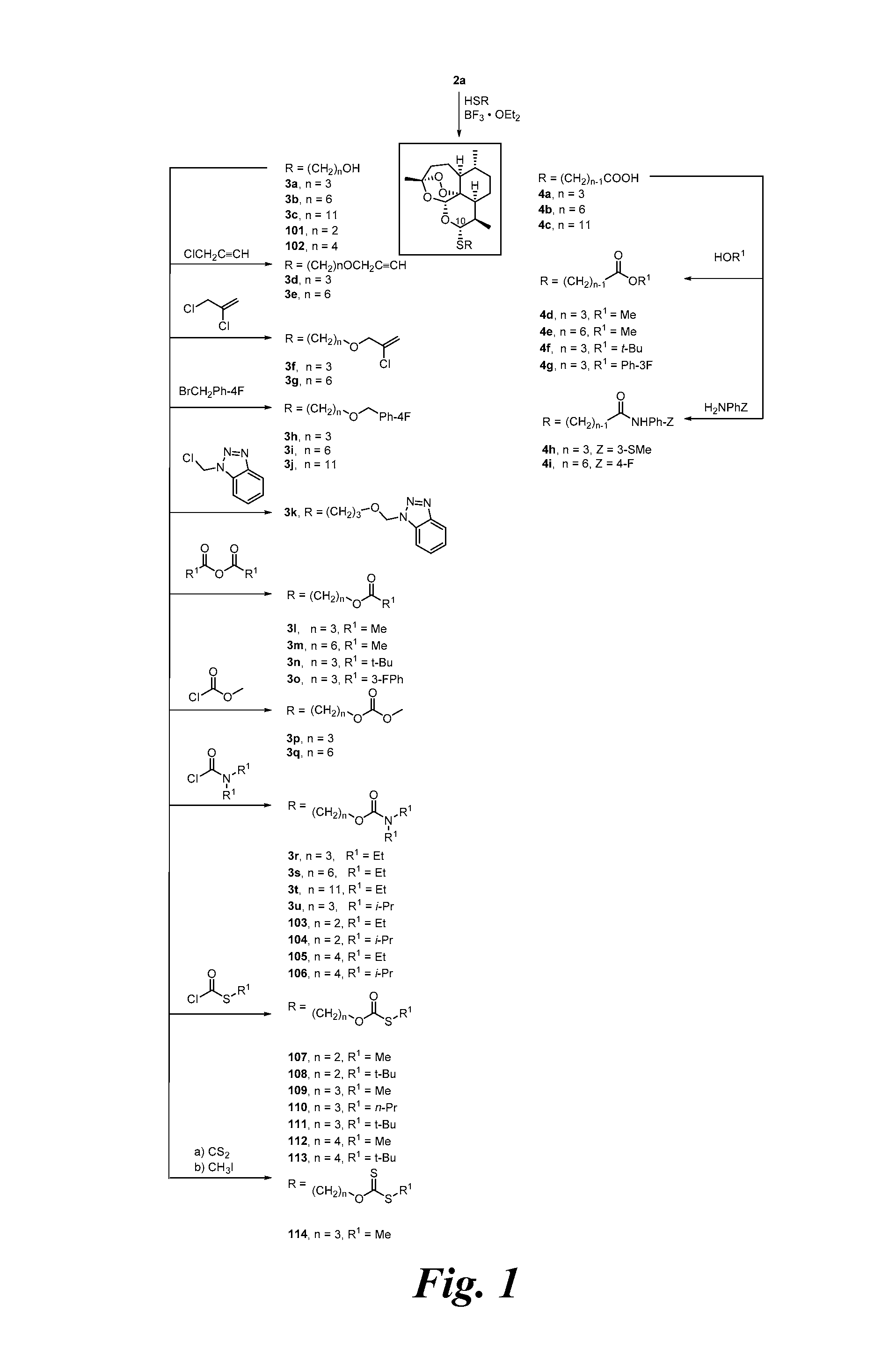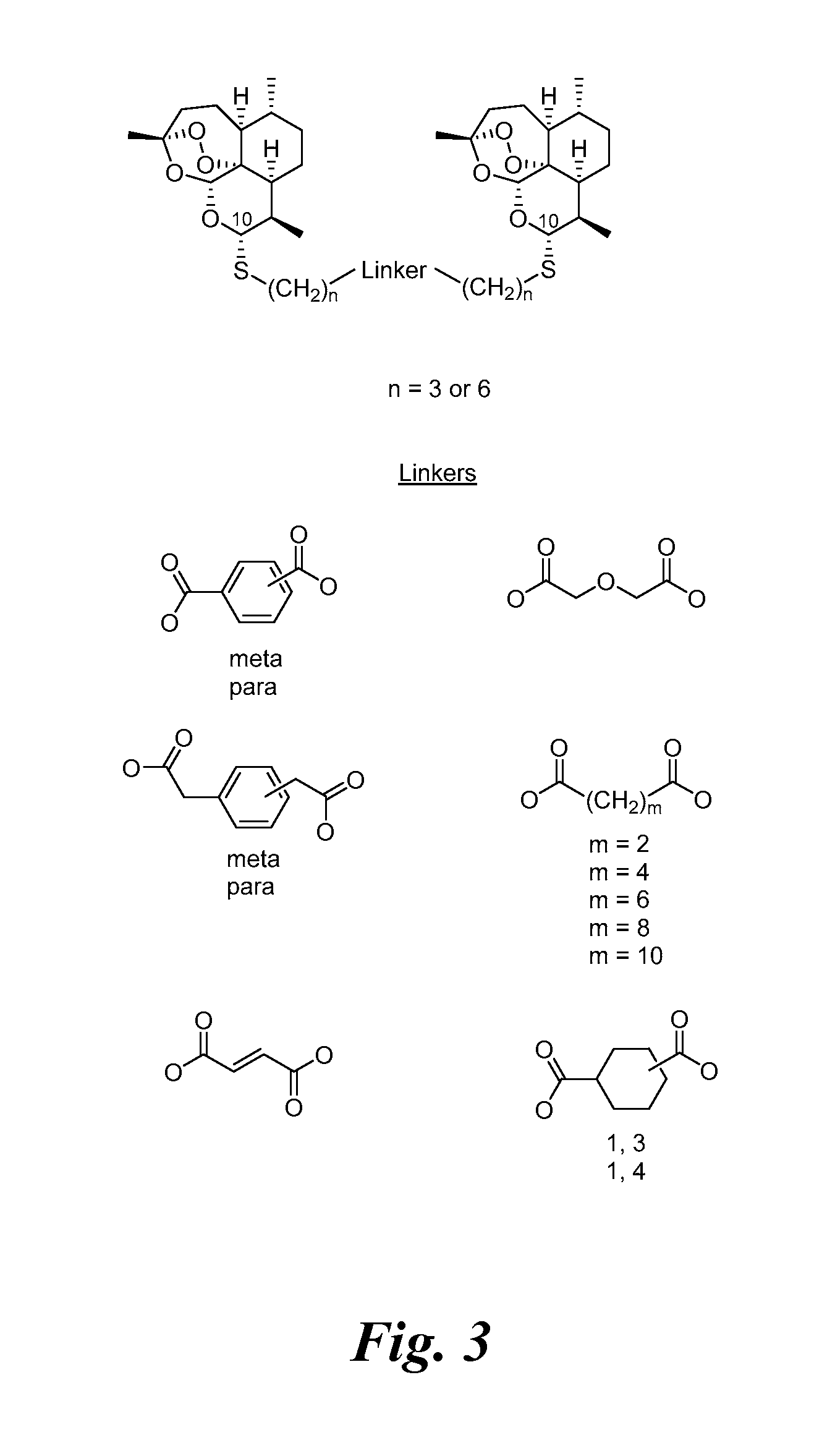Trioxane thioacetal monomers and dimers and methods of use thereof
- Summary
- Abstract
- Description
- Claims
- Application Information
AI Technical Summary
Benefits of technology
Problems solved by technology
Method used
Image
Examples
example 1
[0232]In only 2 high-yielding chemical steps from natural artemisinin (1), a series of C-10 thioacetal alcohols 3a-3c was prepared (FIG. 1). In all cases, the C-10-α thioacetal diastereomer strongly predominated over the C-10-β diastereomer. Chromatography provided the pure C-10-α diastereomer. Based on its proton NMR J9,10 coupling constant of 9-11 Hz, C-10-α thioacetal stereochemistry was assigned. See Oh, et al., 2003.
[0233]Previously a C-10-α phenylthioacetal and a C-10-α cyclohexylthioacetal were shown to be more antimalarially efficacious in mice than the corresponding C-10-β diastereomer. See Venugopalan, et al., 1995; Oh, et al., 2003. One-step O-alkylation gave propargyl ethers 3d and 3e, allylic ethers 3f and 3g, and benzylic ethers 3h-3j in good yields. One-step acylation converted thioacetal alcohols 3a-3c into esters 3l-3o, into carbonates 3p and 3q, and into carbamates 3r-3u also in good yields. Likewise, thioacetal carboxylic acids 4a-4c, prepared in only 2 s...
example 2
Representative Biological Data
[0236]Using a standard protocol, see Slack, et al., 2012, 20-gram mice were infected by intraperitonial injection with P. berghei malaria parasites. One day after infection, each mouse in groups of 4 mice received a single oral dose of 6 mg / kg body weight of a trioxane thioacetal combined with 18 mg / kg of the long-lived antimalarial mefloquine hydrochloride. In all cases, parasitemia was decreased by at least 99% on day 3 post infection. Malaria-infected mice receiving no antimalarial drug died on day 6 or 7 post infection. Critically, control groups of mice receiving 6 mg / kg of the popular trioxane drug artemether (2b) plus 18 mg / kg of mefloquine, or just 18 mg / kg of mefloquine alone, survived for about 3 weeks post infection. In contrast, several of the presently disclosed trioxane thioacetals prolonged mouse survival for longer than 3 weeks, and in some instances produced partial cures; for example, 2 of 4 mice in one group (diisopropyl carbamate 3u)...
example 3
Experimental Methods and Analytical Data
Art-10α-S(CH2)3OH (3a)
[0238]
[0239]An oven-dried, 5 dram vial, equipped with a magnetic stir bar, under argon was charged with dihydroartemisinin (2a, 250 mg, 0.88 mmol, 1.0 equiv) and anhydrous dichloromethane (10 mL). 3-Mercaptopropanol (89 mg, 0.97 mmol, 1.1 equiv) was added and allowed to stir for 10 min at 50° C., under argon. Boron trifluoride etherate (0.125 mL, 0.88 mmol, 1.0 equiv) was added dropwise and the reaction was allowed to stir under argon at 50° C. for 30 min. After 30 min, the reaction was quenched with water (5 mL) and extracted with dichloromethane (3×10 mL). The organic layers were combined, dried over MgSO4, and concentrated on a rotary evaporator at room temperature. The 1H NMR of the crude reaction mixture indicated a mixture of 10-α and 10-β diastereomers in a ratio of 9:1 (α:β). The crude amorphous solid was purified via column chromatography (10% ethyl acetate in hexanes) to afford the desired product 3a as an amorp...
PUM
| Property | Measurement | Unit |
|---|---|---|
| Composition | aaaaa | aaaaa |
| Disorder | aaaaa | aaaaa |
Abstract
Description
Claims
Application Information
 Login to View More
Login to View More - R&D
- Intellectual Property
- Life Sciences
- Materials
- Tech Scout
- Unparalleled Data Quality
- Higher Quality Content
- 60% Fewer Hallucinations
Browse by: Latest US Patents, China's latest patents, Technical Efficacy Thesaurus, Application Domain, Technology Topic, Popular Technical Reports.
© 2025 PatSnap. All rights reserved.Legal|Privacy policy|Modern Slavery Act Transparency Statement|Sitemap|About US| Contact US: help@patsnap.com



